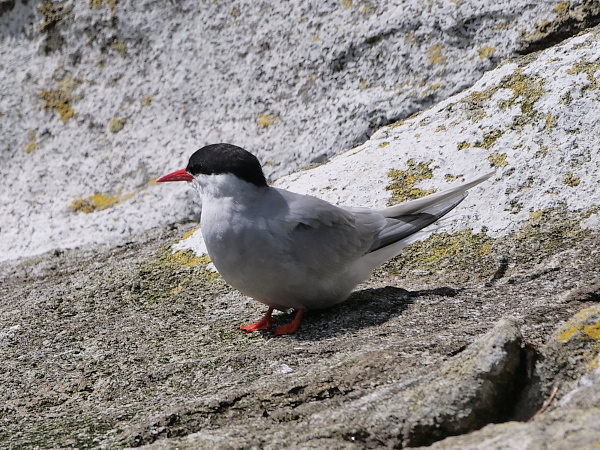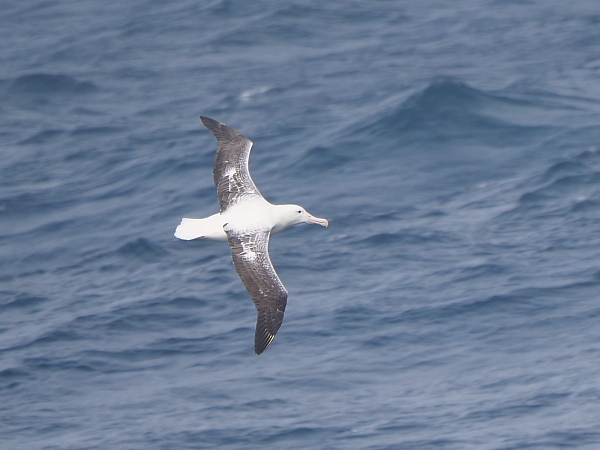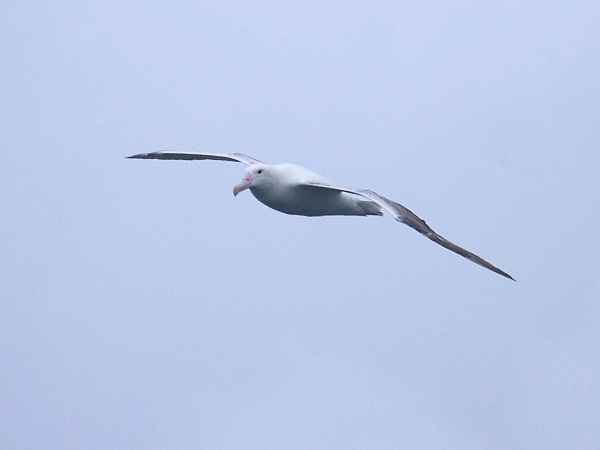Thursday 07 December. Our first night on board was fairly
choppy and I rolled about a bit as we voyaged south. My berth was perpendicular
to the ship's sides although I'm not sure if that was advantageous or not. We were
up soon after 05:00 and on deck 6 overlooking the stern seawatching from 05:30-09:00
when we arrived off the Snares. There were lots of seabirds although it was hard
to find shelter, commonest were Cape Petrels, unidentified prions,
Sooty Shearwaters and Common Diving Petrels.
After a quick breakfast we were back on deck watching the Zodiacs
being winched from the rear deck down onto the sea. One appeared to deflate on the
way but the others were prepared and came alongside to the gangway in turn to be
loaded, 10 per boat. This was a slow process with 13-14 Zodiacs to load and each
passenger being guided by two crew (one on each arm) from the loading platform to
two in the boat. For us, in one of the last Zodiacs, it took almost two hours before
we departed. We were on the Zodiac for almost 3 hours, cruising close, sometimes
very close up and down the Eastern coast of the main island. It was brilliant, allowing
close views of hundreds of Snares Penguins, one the rocky shore and it the
water. Other highlights were good views of Snares Fernbird and the all black
Snares Tomtit but it was only when we were back on board the Heritage Adventurer
that we learned, despite all Zodiacs being in radio contact with each other and
the mother ship, that several Zodiacs had encountered a Snares Snipe (seen by a
few, heard by more) and others a vagrant White-throated Needletail. This was disappointing
although our driver being a botanist probably didn't make a difference to whether
we saw those species or not. Not matching clients interests to the expertise of
the guide with them was the one area where the expedition arrangements could have
been better, for birders as well as non-birders. Despite the cruise being called
Birding Down Under many of the clients were not particularly keen birders with fewer
than 25% appearing on deck with any regularity. It shouldn't have been difficult
to arrange for the keen birders to always be in Zodiacs with bird guides. As it
was it was pot luck whether one's Zodiac driver's expertise matched the interests
of those with them.
We were back on board for a late lunch by 14:00 and soon after we
headed south. Seawatching from deck continued to be excellent (Black-bellied
Storm-Petrels, various Albatrosses, Northern Giant and Mottled
Petrels) although we realised that the rear of deck 5 or alongside the bridge
on deck 6 were more sheltered. Seawatching was interrupted late afternoon by a biosecurity
check as the following day we would be going ashore at Enderby (one of the Auckland
Islands). Depending on who was checking you this could be an easy process although
on my first go I was sent away to remove some tiny seeds from velcro and webbing.
Velcro is the main culprit, something I wished I'd known when choosing what to bring.
I returned to deck for more seawatching, with a break for dinner, writing up brief
notes after dark (22:00). A long day! There was a programme of talks with one or
two most afternoons, many of which sounded interesting and it would have been nice
had they been recorded so one could see them at a later date. As it was none beat
the draw of seawatching so I missed them all. Neither did attending a bird log although
if we were landing somewhere the following day we turned up to hear what the options
were.
Birds I saw during a brilliant first day proper were (new birds in red): 20 Red-billed
and a Kelp Gull, White-fronted Tern, 30 Antarctic Terns, 8
Brown Skuas, 1000+ Snares Penguins, 40 Black-bellied
Storm-Petrels, a probable Gibson's, 8 Southern Royal,2
Campbell, 40 Shy, 15 Salvin's and a poor view of a nesting Buller's
Albatross, 6 Northern Giant Petrels, Southern
Fulmar, 500+ Cape Petrels, 2+ Broad-billed, 50+ Fairy and 2 potential Fulmar Prions, Mottled Petrel, 15 White-chinned Petrels, 200+ Sooty Shearwaters,
150+ Common Diving-Petrels, 30 Cormorants (vagrants from
Australia?), 8 Snares Tomtits, 2 Welcome Swallows, 4 Snares Fernbirds,
2 Blackbirds and Lesser Redpoll heard.
 |
| Salvin's Albatross north of the Snares |
 |
| Shy Albatross north of the Snares |
 |
Shy Albatross (photo: Paul Noakes)
|
 |
Common Diving-Petrel and Broad-billed Prion
|
 |
| Broad-billed Prion (photo: Paul Noakes) |
 |
| Broad-billed Prion and Cape Petrel |
 |
| Cape Petrels |
 |
| Common Diving-Petrels |
 |
| Common Diving-Petrel (photo: Paul Noakes) |
 |
| approaching the Snares |
 |
| penguins ahoy |

 |
| Fairy Prions south of the Snares (photo: Paul Noakes) |
[enhanced blog reposted 31 March 2024]












































































No comments:
Post a Comment
Note: only a member of this blog may post a comment.